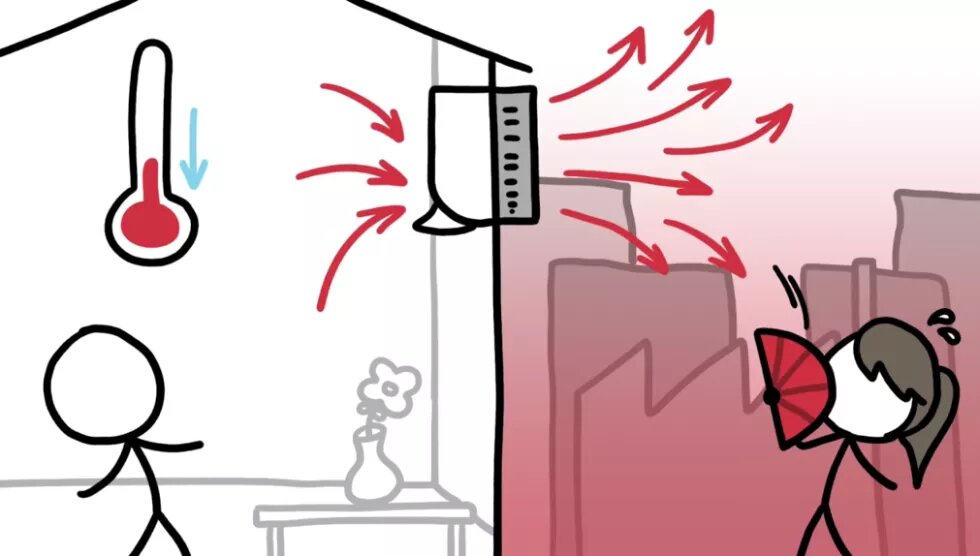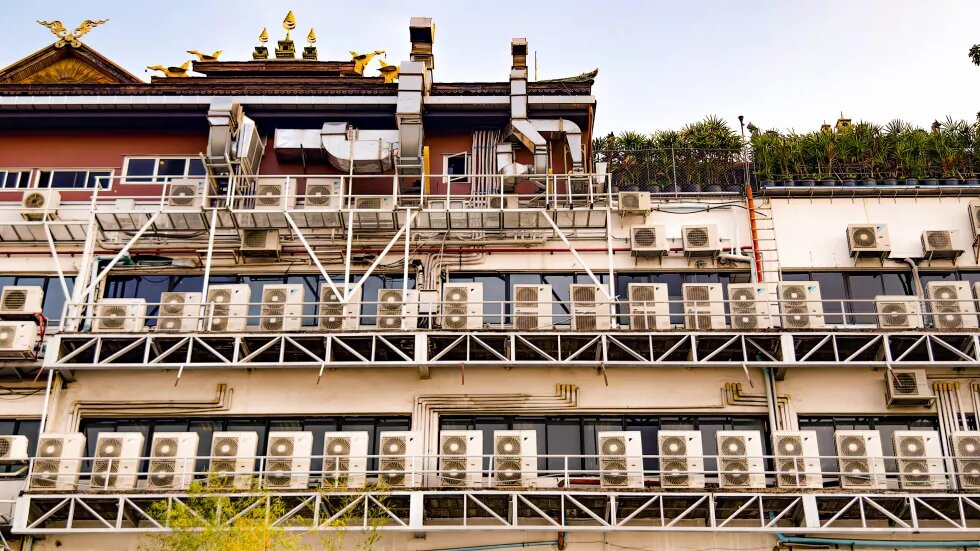
Air conditioners and refrigerators save lives during heat waves, keep food and vaccines from spoiling, and make life in hot and humid Thailand more livable. But keeping our indoor climate cool has ironically made the outdoor climate much warmer. Countering the global-warming effect of air conditioners and refrigerators is a major challenge that needs urgent attention.

กรุณาคลิกที่นี่เพื่ออ่านบทความนี้เป็นภาษาไทย
The vicious heating-cooling cycle
Air conditioning and refrigeration heats the planet in subtle but nefarious ways. Because over 70% of electricity consumed in Thailand is generated from natural gas, coal and fuel oil, air conditioning and refrigeration contributes to carbon dioxide (CO2) emissions from burning these fossil fuels. However, this is not their only problem.
Air conditioners (ACs) cool buildings and cars by moving heat from inside to outside. Refrigerators do the same thing to the air around them. If they are located inside a building with air conditioning, the ACs will have to work even harder to remove the heat from the refrigerators too. They pump out enough heat to warm an entire city by a few degrees (see Figure 1).
In addition, when we get rid of our old ACs or refrigerators, most of their chemical refrigerants leak out and evaporate. Some also leak out during the production, transportation, maintenance, and daily use. These refrigerants happen to be greenhouse gases that are thousands of times more potent than CO2 at trapping the earth’s heat. They warm the planet 90% extra on top of the warming from the CO2 released to run the ACs.
As the earth gets warmer and warmer, we use more air conditioning and our refrigerators work harder to keep things inside cool. These heat up the earth even more in a vicious feedback loop that gets worse and worse over time. The problem gets compounded as developing countries get richer and more people buy more air conditioners and refrigerators.
In Thailand, refrigeration and air-conditioning already use about 50% of the electricity consumed in the country. Without intervention, “this demand will triple by 2030.”
Globally, the trend is similar. The world’s energy use from air conditioning will more than triple by 2050, equal to how much electricity the entire country of China consumes today. The International Energy Agency considers the alarming growth in electricity consumption for cooling “one of the most critical yet often overlooked energy issues of our time.”
Practical strategies for public awareness and industry change
To avert the life-threatening global impacts this will have, we will need a coordinated effort by the government, private sector, and consumers in mobilizing the following actions and solutions.
- We, as consumers, will need to use the most efficient refrigerators and air conditioners. Thailand used to be a leader in appliance labeling but the ‘No. 5’ program is sorely in need of systematic updates as technology continues to improve (see Figure 2.) Most products, notably less efficient ones, also choose to forego any labeling. To make the program more effective, the government needs to issue an appliance standards and labeling standards so manufacturers are required to meet them and disclose energy usage information to enable consumers to make informed choices when selecting a refrigerator or AC. This rule should extend to commercial branded carbonated drinks refrigerators or ice-cream freezers ‘on loan for free’ to shops and/or restaurant owners as they are among the worst energy-efficient refrigerators available.[1]
- Thailand needs to quickly transition to generating electricity in a way that doesn’t release heat or CO2. This means phasing out coal and gas-fired generation and investing in energy efficiency and renewable energy and energy storage.
- When we get rid of our old refrigerators or air conditioners, we’ll need to recycle or destroy their refrigerants, and not release them into the atmosphere as is currently practiced.
- The government and the private sector will also need to work together to accelerate the switch over to refrigerants that will not trap heat. We phased out freons or chlorofluorocarbons (CFCs) that were 10,000 times more potent than CO2 in trapping heat. But the most prevalent coolants used in Thailand – hydrofluorocarbon (HCF) and hydrochlorofluorocarbon (HCFC), also commercially known as R32, R22 and R400s – are still 675–2,000 times more potent than CO2. Luckily new hydrocarbon (HC) refrigerants with a global warming potential of only 3 are available in the market. We just need education (perhaps through a refrigerant label as shown in Figure 3?) and support to ensure a faster switch to more environmentally friendly chemicals (also known as R290/R600a) (see Table 1).
- We’ll also have to figure out how to use less air conditioning, some of which we can do by using fans until it gets too hot. There are also other cooling technologies that do not depend on the use of refrigerants that cause global warming. These include evaporative cooling, desiccant-based (adsorption) air conditioning [2], reflective and radiative air conditioning, for example.
There are many strategies for making our buildings and homes cooler, such as making the roofs and building façade shiny white to reflect heat, ‘greening’ the roofs with plants and soil that reflect, insulate and evaporate, having windows on opposite sides of the buildings so air can easily flow through, choosing insulating materials for building roofs and walls to keep the heat out, and adding shades in the form of awnings or trees to keep the sun off the walls and windows. We also need to redesign our cities to include more green spaces with trees that can provide shade, encourage hot air to mix with cool air, and cool the air themselves through evaporation (see Figure 4).
We are at a crossroad. Let’s not go down the path of unmanageable cooling energy demand growth, and take collective action toward a sustainable cooling outcome for the planet.
__
Chuenchom Sangarasri Greacen is an independent energy analyst and co-founder of Palang Thai, a nongovernmental organization that conducts public-interest research and works for fair, sustainable, and democratic development of the energy sector in Thailand and the Mekong region.
The views expressed in this article are not necessarily those of Heinrich Böll Stiftung.
Notes
[1] Based on the author’s own measurements using an appliance meter. An EST cola refrigerator with a glass display was found to be running at a constant level (no off cycle for the compressor) with a daily consumption of 10.1 kWh/day or around THB 54 p/day or THB 1,600 p/month of electricity cost (including VAT – value added tax). Est Cola alone has 150,000 of these refrigerators nation-wide and they use R-400s refrigerants which have 1,000–3,000 times the global warming potential of CO2. Other brands, such as Coca Cola and Pepsi, not to mention beer and ice-cream companies, also have similar refrigerators distributed throughout Thailand.
[2] See National Renewable Energy Laboratory (NREL) presentation on Desiccant Enhanced Evaporative Air Conditioning; Abdelgaied, M., Saber, M.A., Bassuoni, M.M. et al. article on Adsorption air conditioning: a comprehensive review in desiccant materials, system progress, and recent studies on different configurations of hybrid solid desiccant air conditioning systems; and Tech Ingredients’ Revolutionary Air Conditioner! for more.



